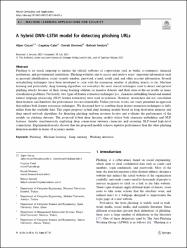| dc.contributor.author | Özcan, Alper | |
| dc.contributor.author | Çatal, Çağatay | |
| dc.contributor.author | Dönmez, Emrah | |
| dc.contributor.author | Şentürk, Behçet | |
| dc.date.accessioned | 2021-08-20T20:10:45Z | |
| dc.date.available | 2021-08-20T20:10:45Z | |
| dc.date.issued | 2021 | en_US |
| dc.identifier.citation | Ozcan, A., Catal, C., Donmez, E., & Senturk, B. (2021). A hybrid DNN–LSTM model for detecting phishing URLs. Neural Computing and Applications, 1-17. | en_US |
| dc.identifier.issn | 0941-0643 | en_US |
| dc.identifier.issn | 1433-3058 | en_US |
| dc.identifier.uri | https://doi.org/10.1007/s00521-021-06401-z | |
| dc.identifier.uri | https://hdl.handle.net/20.500.12899/336 | |
| dc.description.abstract | Phishing is an attack targeting to imitate the official websites of corporations such as banks, e-commerce, financial institutions, and governmental institutions. Phishing websites aim to access and retrieve users’ important information such as personal identification, social security number, password, e-mail, credit card, and other account information. Several anti-phishing techniques have been developed to cope with the increasing number of phishing attacks so far. Machine learning and particularly, deep learning algorithms are nowadays the most crucial techniques used to detect and prevent phishing attacks because of their strong learning abilities on massive datasets and their state-of-the-art results in many classification problems. Previously, two types of feature extraction techniques [i.e., character embedding-based and manual natural language processing (NLP) feature extraction] were used in isolation. However, researchers did not consolidate these features and therefore, the performance was not remarkable. Unlike previous works, our study presented an approach that utilizes both feature extraction techniques. We discussed how to combine these feature extraction techniques to fully utilize from the available data. This paper proposes hybrid deep learning models based on long short-term memory and deep neural network algorithms for detecting phishing uniform resource locator and evaluates the performance of the models on phishing datasets. The proposed hybrid deep learning models utilize both character embedding and NLP features, thereby simultaneously exploiting deep connections between characters and revealing NLP-based high-level connections. Experimental results showed that the proposed models achieve superior performance than the other phishing detection models in terms of accuracy metric. | en_US |
| dc.language.iso | en | en_US |
| dc.publisher | Springer | en_US |
| dc.relation.ispartof | Neural Computing and Applications | en_US |
| dc.rights | info:eu-repo/semantics/openAccess | en_US |
| dc.subject | Phishing | en_US |
| dc.subject | Machine learning | en_US |
| dc.subject | Deep learning | en_US |
| dc.subject | Phishing detection | en_US |
| dc.title | A hybrid DNN–LSTM model for detecting phishing URLs | en_US |
| dc.type | Article | en_US |
| dc.authorid | 0000-0003-3345-8344 | en_US |
| dc.department | MTÖ Üniversitesi, Sosyal ve Beşeri Bilimler Fakültesi, Yönetim Bilişim Sistemleri Bölümü | en_US |
| dc.institutionauthor | Dönmez, Emrah | |
| dc.identifier.doi | 10.1007/s00521-021-06401-z | |
| dc.identifier.startpage | 1 | en_US |
| dc.identifier.endpage | 17 | en_US |
| dc.relation.publicationcategory | Makale - Uluslararası Hakemli Dergi - Kurum Öğretim Elemanı | en_US |
| dc.identifier.scopus | 2-s2.0-85112070505 | en_US |
| dc.identifier.scopusquality | Q1 | en_US |
| dc.identifier.wos | WOS:000682813600001 | en_US |
| dc.identifier.wosquality | Q2 | en_US |
| dc.indekslendigikaynak | Web of Science | en_US |
| dc.indekslendigikaynak | Scopus | en_US |


















